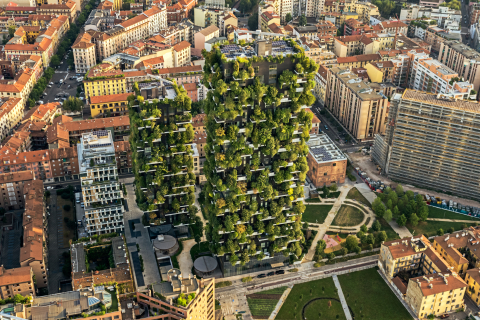After the Renowned Vertical Forest in Milan, the Concept of Urban Forestry by Architect Stefano Boeri Spreads in Northern Europe, Starting From Eindhoven, Utrecht and Antwerp
After the Renowned Vertical Forest in Milan, the Concept of Urban Forestry by Architect Stefano Boeri Spreads in Northern Europe, Starting From Eindhoven, Utrecht and Antwerp
MILAN--(BUSINESS WIRE)--Worldwide, cities produce about 70% of the CO2 present in the atmosphere, while forests and woods are able to absorb 40% of it. Increasing wooded areas within and around cities would multiply the resilience capacities of urban areas and would drastically reduce the production of CO2, thanks to plant-based photosynthesis processes.
“We have entered a new phase of human history, in which we will finally see a new alliance between forests and cities, two environments that our species has always kept separate; one as the maximum expression of artifice, and the other as the maximum expression of naturalness. Trees and woods will no longer be just a decorative presence or a natural environment to be circumscribed in protected areas, they will become an integral part of the life sphere of millions of citizens in the world. Protecting forests, reforesting cities and growing newly founded Forest-Cities: these are the great challenges to be faced immediately, all together, if we want to tackle Climate Change” affirms architect and urbanist Stefano Boeri, founder of the practice Stefano Boeri Architetti and author of the globally renowned Vertical Forest in Milan (Bosco Verticale), a building that contributed to the development of the Urban Forestry concept worldwide.
Stefano Boeri Architetti’s Research Department leads the international debate and development of green and sustainable urban design in Europe and in many countries around the world. Its contribution to the debate on the ecological transition of cities and its strategic role in the urban and peri-urban environmental regeneration movement, adopting a biophilic and nature-based approach, places the whole team at the forefront of both the academic and practical development of enhanced, mixed-use Nature-Based Solutions and Urban Forestry design projects.
“Nature-based solutions can favor sustainable urbanization, restore degraded ecosystems, improve climate change adaptation and mitigation, and help risk management and resilience. Furthermore, by reshaping the urban environment, Nature-based Solutions can enhance inclusivity, equitability and livability, regenerate deprived districts, improve citizens’ mental and physical health and quality of life, reduce violence, and decrease social tensions through better social cohesion, particularly for the most vulnerable groups e.g. children, elderly and people of low socio-economic status” declares architect Francesca Cesa Bianchi, partner of Stefano Boeri Architetti.
In the Netherlands, Stefano Boeri Architetti is building the first Vertical Forest for social housing.
After the experience of the first Vertical Forest in Milan – which also owed its cost to the initial investment in scientific research – the studio worked with great obstinacy on the construction systems (prefabrication) and on the materials needed to make the Vertical Forest accessible to all. And they did it. In recent weeks, the Trudo Vertical Forest, a residential social housing building, will be completed in Eindhoven. The green tower is intended to mainly accommodate popular users, in particular young couples, hosting a series of rent-controlled apartments with high living quality on its 19 floors. Thanks also to the more than 125 trees of various species on the balconies, to which about 5,200 shrubs and smaller plants will be added.
Not far from Eindhoven, in Utrecht, another Vertical Forest is growing. Drawn up by Stefano Boeri Architetti and MVSA Architects, the Wonderwoods project aims to create an advanced experience of cohabitation between city and nature in the center of Utrecht as part of the new Healthy Urban Quarter. Enriched with office areas, spaces for fitness and yoga, bicycle parking and public and recreational spaces, the Wonderwoods Vertical Forest is designed as the new wellness hub in Utrecht. As a form of protection and safeguarding for the biodiversity of living species and in particular the birds that inhabit the Dutch skies, the Wonderwoods Vertical Forest has also been developed to promote the pleasure of contact with nature.
To foster greening in different climatic environments is not a simple task. However, there are several examples showing how innovative methodologies and techniques are able to achieve excellent results; Palazzo Verde in the city of Antwerp (Belgium), developed by Stefano Boeri Architetti is one of these examples.
Palazzo Verde, with its 67 apartments, is the greenest building in all of Belgium: the facades are made up of alternating balconies and loggias, working on the concept of threshold, and moving the boundary between inside and outside. Palazzo Verde houses 86 local trees and 2200 shrubs, for a total of 780 square meters of total green area, accessible by residents directly from the stairwells and recognizable as a protected and inclusive space, obtained by positioning trees and shrubs at the edges of the terraces themselves.
Adopting strategies that combine technological innovation with locally adapted and climate-appropriate Nature-Based Solutions, can truly help cities and communities mitigate the effects of climate change and provide positive long-term social, environmental and economic benefits.
Contacts
Press Office
Elettra Zadra
press@stefanoboeriarchitetti.net

